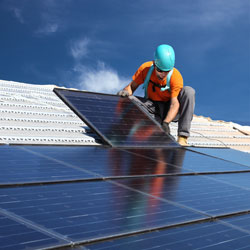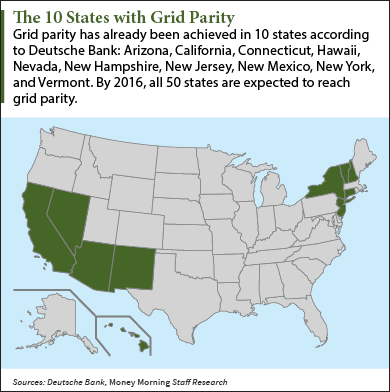 The potential of solar power has been touted for years, yet it has always come with major limitations. The costs of producing solar power have outweighed the benefits for many power companies.
The potential of solar power has been touted for years, yet it has always come with major limitations. The costs of producing solar power have outweighed the benefits for many power companies.
But that's changing. Solar power has reached a tipping point, and it's creating a massive profit opportunity for one solar ETF.
"Despite the odds, alternative energy - led by solar power - is rapidly approaching what the industry has always considered to be the 'Holy Grail,'" Money Morning's Global Energy Strategist Dr. Kent Moors said.
Why Solar Energy Is About to Become Profitable
Solar has always been too expensive for most industries to adopt.
"New energy projects require intensive amounts of working capital to make them fully compatible with traditional methods of generating power, and there's the widely held assumption that renewables can't survive absent government subsidies and benefits," Moors said.
There has also been the tricky problem of producing power when there is no sunlight.
But these problems are quickly fading, thanks to grid parity.
"Grid parity reflects renewables' ability to generate power for the same underlying cost as competing sources like oil, natural gas, or coal," Moors explained. "In other words, it's the point at which the cost of generating renewable energy suddenly becomes equal to its peers."
In Deutsche Bank's 2015 solar outlook, analysts noted grid parity had been reached in 10 U.S. states at the end of 2014. All 50 states are expected to reach parity by 2016. By 2017, analysts expect 80% of the global market will have reached grid parity.
The same report indicates the price of solar modules should fall roughly 40% within the next four or five years.
"We believe the trend is clear: grid parity without subsidies is already here, increasing parity will occur, and solar penetration rates are set to ramp worldwide," the report says.
We've already seen the impact.
 Mother Jones reported in November the amount of solar power produced in the U.S. had leaped 139,000% in the past 10 years.
Mother Jones reported in November the amount of solar power produced in the U.S. had leaped 139,000% in the past 10 years.
That's created thousands of new jobs. According to the Solar Foundation, there are now 174,000 people employed in the solar industry. By comparison, the number of coal miners, and people involved with coal transportation or coal power plants totaled just 80,000 in 2006. And many coal facilities have shuttered operations since then.
The Solar Foundation also says that 1.3% of all new jobs created in the U.S. since 2013 have been from the solar industry.
And solar power still only accounts for a fraction of the market...
The U.S. Energy Information Administration (EIA) reported solar made up just 0.2% of all energy generated in the U.S. in 2013. So it still has incredible potential for further market penetration.
In the U.K., solar power is expected to provide up to 4% of the nation's power by 2020. The price of solar panels has already dropped 70% there in the past several years, the BBC says.
But individual solar stocks are very volatile. That's why the best way to profit from the industry now is with a solar ETF. It's a safer play. Plus, you'll be getting exposure to the entire industry, not just one company.
Here's the solar ETF we like now...
The Best Solar ETF to Buy Now
Our recommendation is the Guggenheim Solar ETF (NYSE: TAN), which tracks the performance of the MAC Global Solar Energy Index. The fund controls nearly $381 million in assets.
The average market cap of TAN's holdings is $3.3 billion. So it generally invests in smaller companies. Its average trading volume is good, at 359,000 shares per day.
[epom key="ddec3ef33420ef7c9964a4695c349764" redirect="" sourceid="" imported="false"]
TAN invests in 29 stocks, but the top five holdings account for 38.6% of the fund's assets. Roughly 47% of the fund's assets are invested in U.S. companies. Nearly 23% of the holdings are based in China and another 21% in Hong Kong.
Some of this solar ETF's more important holdings include:
- Hanergy Thin-Film Power Group Ltd. is a Chinese company that develops products for the thin-film solar industry. The company trades on the Hong Kong stock exchange and has a market cap of $275 billion. In the last year, Hanergy stock is up 389%.
- SunEdison Inc. (NYSE: SUNE) develops, builds, and operates solar power plants. It also makes solar power modules and silicon wafers for the semiconductor industry. SUNE is a smaller company, with a market cap of $6.8 billion. The fund invests 8.37% of its assets in SunEdison, and the stock is up 22% year to date.
- First Solar Inc. (Nasdaq: FSLR) manufactures solar panels, solar power plants, and thin-film modules. The $6.2 billion company is one of the biggest names in the solar power industry. Year to date, FSLR has climbed 35%. First Solar accounts for 7.33% of the fund's holdings.
Shares closed March 25 at $44.03. They've climbed more than 29% in 2015.
Dr. Moors went across the pond to address the Annual Energy Consultation of the Windsor Energy Group (WEG) on the current state of the energy market. First on his list of items to note: the $5 trillion global problem in the energy sector. Here's everything you need to know about and how it will affect you...
Related Articles:
- Deutsche Bank: Deutsche Bank's 2015 Solar Outlook
- Mother Jones: Here Comes the Sun: America's Solar Boom, in Charts
- BBC: Solar Energy 'Could Provide 4% of UK Electricity by 2020'


